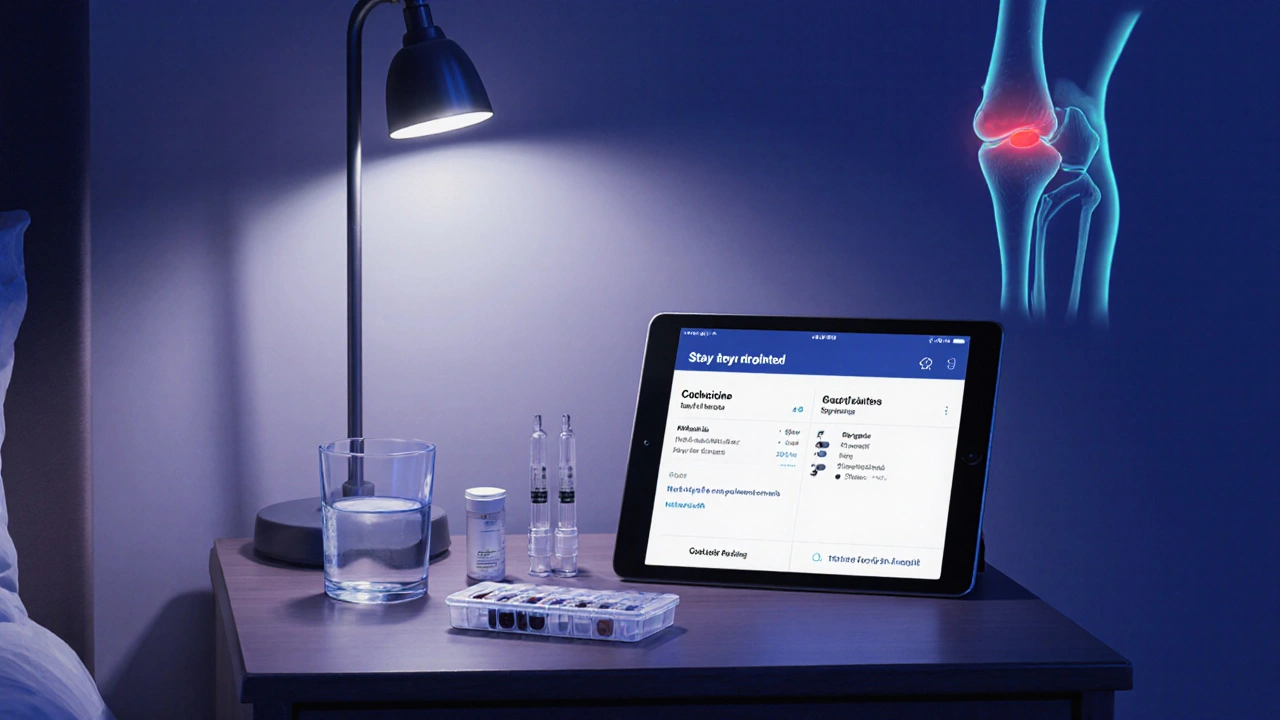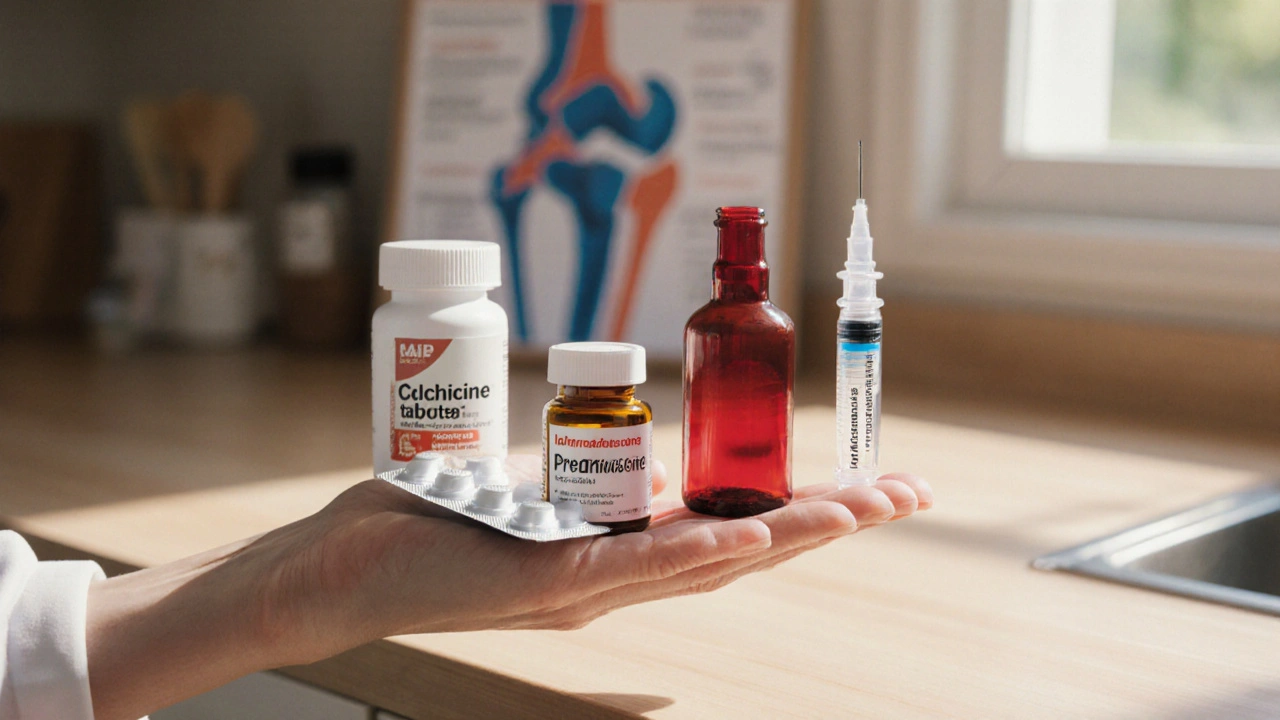Gout Treatment Decision Tool
Personalized Treatment Calculator
Answer these questions to get treatment recommendations based on your health profile.
Treatment Recommendations
When you’re weighing colchicine alternatives, the key is to match the drug’s strengths with your health profile and how fast you need relief. Below you’ll find a side‑by‑side look at colchicine and the other meds doctors reach for during an acute gout flare.
Key Takeaways
- Colchicine works fast but can upset the stomach; it’s a solid choice if you have heart disease or kidney issues.
- NSAIDs give quick pain relief but raise bleeding risk, especially in older adults.
- Corticosteroids calm inflammation without harming the gut, but long‑term use can spike blood sugar and bone loss.
- IL‑1 inhibitors target the inflammation pathway directly; they’re pricey but useful for patients who can’t tolerate other drugs.
- Your personal factors-renal function, cardiovascular health, other meds-should drive the final decision.
What is Colchicine?
Colchicine is a plant‑derived alkaloid that interferes with microtubule formation, halting the migration of neutrophils to the joint where uric acid crystals sit. By stopping these immune cells, colchicine reduces swelling within hours of a gout attack.
Typical dosing starts at 1.2mg, followed by 0.6mg one hour later, then 0.6mg every 12hours for a few days. The drug is cleared by the kidneys, so dose adjustment is needed for anyone with a glomerular filtration rate (GFR) below 30mL/min.
NSAIDs: The Classic Painkillers
Non‑steroidal anti‑inflammatory drugs (NSAIDs) such as ibuprofen, naproxen, and indomethacin block cyclooxygenase enzymes, cutting prostaglandin production and thus pain and swelling.
For a gout flare, doctors often prescribe indomethacin 50mg three times daily for up to five days. NSAIDs work within 30‑60 minutes, making them the go‑to for fast relief.
The downside? They can irritate the stomach lining, worsen hypertension, and increase bleeding risk-especially in patients taking anticoagulants or with chronic kidney disease.
Corticosteroids: The Fire‑Suppressors
Corticosteroids like prednisone act on the broad inflammatory cascade, reducing cytokine release and vascular permeability.
A typical oral regimen is prednisone 30mg daily for five days then taper. If oral intake is impossible, an intra‑articular injection of methylprednisolone can calm the joint in a single visit.
Short courses are generally safe, but repeated or high‑dose use may raise blood sugar, trigger mood swings, and weaken bones.
IL‑1 Inhibitors: The Targeted Blockers
Interleukin‑1 (IL‑1) inhibitors such as anakinra and canakinumab block the IL‑1β cytokine that drives gout inflammation.
Anakinra is given as a 100mg subcutaneous injection daily for up to three days. Canakinumab is a single 150mg subcutaneous dose lasting weeks.
These agents are expensive and generally reserved for patients who can’t tolerate colchicine, NSAIDs, or steroids-often those with severe renal impairment or multiple drug interactions.
How to Choose the Right Option
Below is a quick decision tree you can run through before you call the pharmacy:
- Do you have normal kidney function (GFR>60mL/min) and no serious heart disease? Yes: NSAIDs or colchicine are both fine.
- Are you on anticoagulants or have a history of stomach ulcers? Yes: Skip NSAIDs; consider colchicine (dose‑adjusted) or a short steroid tap.
- Do you have chronic kidney disease (GFR<30mL/min) or are you on multiple interacting meds? Yes: Low‑dose colchicine or an IL‑1 inhibitor may be safest.
- Is cost a major concern? Yes: NSAIDs and generic colchicine are the most affordable.
Always discuss these factors with your clinician; they’ll weigh lab results, other prescriptions, and personal preferences.

Comparison Table
| Attribute | Colchicine | NSAIDs | Corticosteroids | IL‑1 Inhibitors |
|---|---|---|---|---|
| Mechanism | Microtubule inhibition → neutrophil migration block | COX inhibition → prostaglandin reduction | Broad anti‑inflammatory → cytokine suppression | Specific IL‑1β blockade |
| Onset of relief | 1-2hours | 30-60minutes | 1-2days (oral) / hours (injection) | Hours (anakinra) / days (canakinumab) |
| Typical dose (acute) | 1.2mg then 0.6mg, then 0.6mg q12h | Indomethacin 50mg TID (5days) | Prednisone 30mg daily ×5days | Anakinra 100mg SC daily ×3days |
| Common side effects | GI upset, diarrhea, rare myopathy | Stomach ulcer, kidney strain, bleed | Elevated glucose, mood change, bone loss | Injection site reaction, infection risk |
| Renal safety | Dose‑adjust if GFR<30mL/min | Use cautiously; can worsen renal function | Generally safe; monitor fluid balance | Often preferred in severe renal impairment |
| Cost (US) | Low (generic) | Low-moderate | Low (generic) - moderate (injectables) | High (biologic pricing) |
Practical Tips for Safe Use
- Start low, go slow: If you’re new to colchicine, begin with the 1.2mg loading dose and watch for diarrhea. If it appears, cut the next dose in half.
- Stay hydrated: Adequate fluids help the kidneys clear colchicine and NSAIDs.
- Check interactions: Colchicine interacts with statins, macrolide antibiotics, and certain antifungals-ask your pharmacist.
- Monitor labs: A baseline creatinine and liver enzyme check is wise before starting chronic colchicine or steroid therapy.
- Plan for flare prevention: Once the acute attack resolves, low‑dose colchicine (0.6mg daily) can reduce future flares, but discuss long‑term risks.
When to Call Your Doctor
If you notice any of these red flags, seek medical help right away:
- Severe, worsening pain after the first 48hours.
- Persistent vomiting or watery diarrhea lasting more than 24hours.
- Signs of infection (fever, redness spreading beyond the joint).
- Sudden decrease in urine output while on colchicine or NSAIDs.
Early intervention can prevent joint damage and keep you out of the emergency room.
Frequently Asked Questions
Can I take colchicine and ibuprofen together?
Usually it’s not recommended because both drugs can stress the kidneys. If you need extra pain relief, talk to your doctor about a short‑term NSAID schedule and a reduced colchicine dose.
What’s the biggest risk of colchicine overdose?
Overdose can cause severe muscle breakdown (rhabdomyolysis), kidney failure, and life‑threatening arrhythmias. Always stick to the prescribed schedule and keep the medication out of reach of children.
Are IL‑1 inhibitors covered by insurance?
Some plans cover them for severe, refractory gout, but prior authorization is common. Check with your insurer and ask your rheumatologist for help with paperwork.
How long can I stay on low‑dose colchicine for prevention?
Long‑term low‑dose use (0.6mg daily) is accepted by many guidelines, but doctors monitor blood counts and kidney function every 6‑12months.
Is it safe to use steroids if I have diabetes?
Short bursts (5‑7days) usually cause only a modest rise in blood sugar. Still, check your glucose more often and let your doctor adjust any diabetes meds if needed.

Val Vaden
October 13, 2025 AT 15:41Colchicine? Just another pill, 🤦♂️
lalitha vadlamani
October 14, 2025 AT 11:08While the article attempts to present a balanced overview, it neglects to emphasize the ethical responsibility physicians bear when prescribing potentially gastro‑toxic agents. The glorification of rapid symptom relief can inadvertently encourage over‑reliance on colchicine without sufficient patient education. Moreover, the superficial treatment of renal dose adjustments borders on negligence. One must remember that the ultimate goal is not merely to quell pain but to safeguard long‑term organ health. Hence, a more cautious narrative would better serve both clinicians and patients.
kirk lapan
October 15, 2025 AT 06:35Listen, if you haven't read the primary literature on colchicine pharmacokinetics, you're basically winging it. The drug's half‑life is not some mysterious number-it sits around 9‑12 hours in patients with normal renal function. When GFR dips below 30, clearance plummets and you must halve the dose, otherwise you risk fatal diarrhoea. Also, the article completely omits the drug‑drug interaction with macrolides and certain statins-big oversight. The classic cytochrome P450 inhibition can push plasma levels sky‑high. And don't even get me started on the myth that NSAIDs are always safer; they can cause acute kidney injury in dehydrated gout patients. So, before you pick a therapy, read the label, not just the marketing blurb. Bottom line: precision matters, not just speed.
Landmark Apostolic Church
October 15, 2025 AT 07:58That’s a solid point, and it reminds me how different cultures view pain relief. In some societies, a slow‑acting approach is preferred, valuing holistic balance over quick fixes. It’s interesting to see how personal beliefs shape medication choices, even when the pharmacology is clear.
Matthew Moss
October 16, 2025 AT 02:01It is imperative that we, as citizens of this great nation, prioritize treatments that uphold our health sovereignty. Colchicine, when used responsibly, aligns with our commitment to robust, self‑reliant medical practices. Let us not be swayed by foreign influences advocating untested alternatives. Simplicity and safety must guide our prescription habits, for the welfare of our people.
Antonio Estrada
October 16, 2025 AT 18:41I completely agree with the balanced view presented. Tailoring treatment to individual renal and cardiac status is indeed the smartest route. Collaboration between patient and physician ensures optimal outcomes.
Andy Jones
October 17, 2025 AT 09:58Wow, what a masterpiece of medical journalism-so many *creative* misspellings of “gout” that one wonders if the author was texting on a broken keyboard. Perhaps next time we’ll see “colchicine” spelled as “colchinine,” just to keep things exciting.
Kevin Huckaby
October 18, 2025 AT 05:25Honestly, throwing IL‑1 inhibitors into the mix feels like using a sledgehammer to crack a walnut 🛠️. Sure, they work, but the price tag is a nightmare and the benefit over colchicine is marginal for most patients. Why not stick to the tried‑and‑true meds unless you’re dealing with a truly refractory case? 💸💊
Brandon McInnis
October 18, 2025 AT 06:31You make a fiery point, and I hear you. Budget constraints are real, and most patients will do fine with colchicine or NSAIDs when monitored correctly. Still, having a backup like an IL‑1 blocker can be a lifesaver for that unlucky minority.
Todd Peeples
October 19, 2025 AT 00:35From a pharmacodynamic perspective, colchicine exerts its anti‑inflammatory effect via microtubule destabilization, thereby attenuating neutrophil chemotaxis. In contrast, IL‑1 blockade targets the upstream cytokine cascade, offering a mechanistic advantage in refractory gout phenotypes. Nevertheless, the cost‑effectiveness ratio (CER) remains unfavorable in standard care pathways, necessitating rigorous health‑economic modeling prior to widespread adoption.
Chris Smith
October 19, 2025 AT 17:15Oh great another miracle drug 🙄
Leonard Greenhall
October 20, 2025 AT 08:31The data presented aligns with current meta‑analyses indicating comparable efficacy between colchicine and NSAIDs for acute flares, with a slight edge in gastrointestinal safety for colchicine when dose‑adjusted. However, the article could benefit from a more robust discussion of the heterogeneity among included trials, particularly regarding baseline renal function stratification.
Abigail Brown
October 21, 2025 AT 06:45Reading through the treatment guide feels like stepping into a garden of possibilities, each medication a different flower blooming with its own scent. Colchicine, the bold sunflower, rises quickly to chase away the pain‑inducing weeds that threaten our joints. NSAIDs, with their bright daisy‑like simplicity, offer swift relief for those who can tolerate a touch of acidity. Corticosteroids, the resilient oak, stand firm, providing sturdy support when inflammation runs deep. IL‑1 inhibitors, the exotic orchid, may be pricey but they reward patience with elegant, targeted action. The key, dear readers, is to listen to your body's whispers, recognizing the subtle cues of kidney health, heart rhythm, and medication history. By honoring these personal signals, you empower yourself to make choices that honor both immediate comfort and long‑term vitality. Imagine a future where a gout flare becomes a brief pause, not a debilitating episode, because you have the right tool at hand. This vision is within reach when clinicians and patients collaborate, sharing knowledge like a well‑tuned duet. So, take heart, explore the calculator, and let the data guide you toward the optimal path. Remember, every successful treatment is a triumph of science and self‑care working hand in hand. Embrace the journey, celebrate small victories, and never underestimate the power of informed decision‑making. With each thoughtful choice, you plant seeds for healthier tomorrows, and those seeds will bloom into stronger, pain‑free days ahead. Keep optimism close, and let evidence‑based medicine be your compass. The road may have twists, but the destination-lasting relief-is undeniably worth the trek.